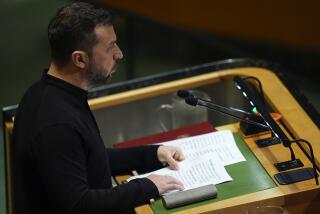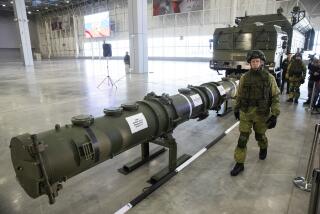Yeltsin Says Heâs Ready to Sign Arms Reduction Treaty : Diplomacy: But the Russian presidentâs proposal for an Alaskan summit next month surprises U.S. officials, who say they thought hard bargaining remained.
BEIJING â Russian President Boris N. Yeltsin announced Friday that he is ready to sign a treaty with the United States to slash the nuclear arsenals of the two nations by more than two-thirds, and proposed doing so at a meeting with President Bush in Alaska next month.
Yeltsinâs unexpected declaration caused consternation in Washington, where American officials said they thought there was still some hard bargaining to do before an agreement could be signed.
âMaybe Yeltsin feels that what has been offered (by the United States) is acceptable, and heâs ready to sign,â one senior official said. âBut we donât know that.â
Yeltsin, jovial after two days of cordial meetings with Chinese leaders, made his announcement about the strategic arms reduction treaty, known as START II, in a largely impromptu speech to Chinese cultural figures.
âThe START II treaty between America and Russia on global cuts and the destruction of strategic nuclear weapons can be signed in the beginning of next January,â Yeltsin said.
âCutting the strategic nuclear forces of the United States and the former Soviet Union by one-third took 15 years of talks,â he said, referring to the START I treaty concluded last year. âFor Russia and the United States to cut by two-thirds has taken less than a year, and in January, weâll sign this treaty.â
Russian Foreign Minister Andrei V. Kozyrev confirmed negotiations were nearly complete.
âThere is still some technical work to be done, but the president is right to say that a political decision has been taken and the agreement can be signed in January,â he told the Associated Press.
Kozyrev said his last round of meetings with Secretary of State Lawrence S. Eagleburger this week had produced âa shift in understanding of the problems.â
But Eagleburger and other U.S. officials said they were mystified by the Russiansâ statements. âI hope heâs right, but we have to see,â Eagleburger said after a meeting of the North Atlantic Treaty Organization in Brussels.
In Washington, White House spokesman Marlin Fitzwater said of the accord, âWeâre getting closer. Weâre hopeful. But thatâs the best we can say.â
State Department officials spent the day seeking some kind of clarification from their Russian counterparts but said their pleas went unanswered.
Bush and Yeltsin agreed last June to the outlines of the treaty, which would cut nuclear weaponry by about two-thirds and eliminate the largest and most dangerous nuclear missiles entirely. But Russian negotiators later asked for changes in details, saying they wanted to preserve some prohibited missiles and silos to reduce the cost of restructuring their nuclear force. The Bush Administration refused; the two sides have been negotiating ever since.
Kozyrev and other Russian officials said Yeltsin decided to conclude the pact after his foreign minister described the negotiating deadlock to him--suggesting, without explicitly saying so, that he may have decided to accept the current American offer.
Yeltsin said Friday he expected âthe whole worldâ to help pay to destroy Russiaâs nuclear weapons--suggesting that firmer assurances of financial aid might assuage Moscowâs objections.
âIt costs as much to destroy strategic nuclear rockets as it does to build them,â he said. âThe United States has so far given us $400 million. This is too little to carry out this grandiose program. But we donât expect to carry it out only at the expense of some aid; we have to do some things ourselves. So this is a common task. I would say this is a task for the whole world.
âIf we reduce the limit on our strategic nuclear warheads from 13,000 in each country to 2,500 or 3,000, that means tranquillity for the world,â he added. âThatâs very important.â
Russian negotiators have asked for three changes in the pact. First, they wanted to use the underground silos built for the giant, now-prohibited SS-18 missile to house smaller missiles, to save on costs. Second, they wanted to turn the multiple-warhead SS-19 missile into a single-warhead missile by simply removing warheads, also to save on costs. Third, they wanted the U.S. Air Force to accept stricter limits on its ability to switch bombers between nuclear and non-nuclear duties, to make it more difficult for the United States to violate the treaty.
U.S. negotiators have reportedly offered compromises on the SS-19 and Air Force issues, but have dug in their heels on the question of the silos--because allowing the Russians to keep the silos would make it more difficult for the United States to verify that the old SS-18 missiles are truly gone.
Goldberg reported from Beijing, and McManus reported from Washington.
More to Read
Sign up for Essential California
The most important California stories and recommendations in your inbox every morning.
You may occasionally receive promotional content from the Los Angeles Times.











